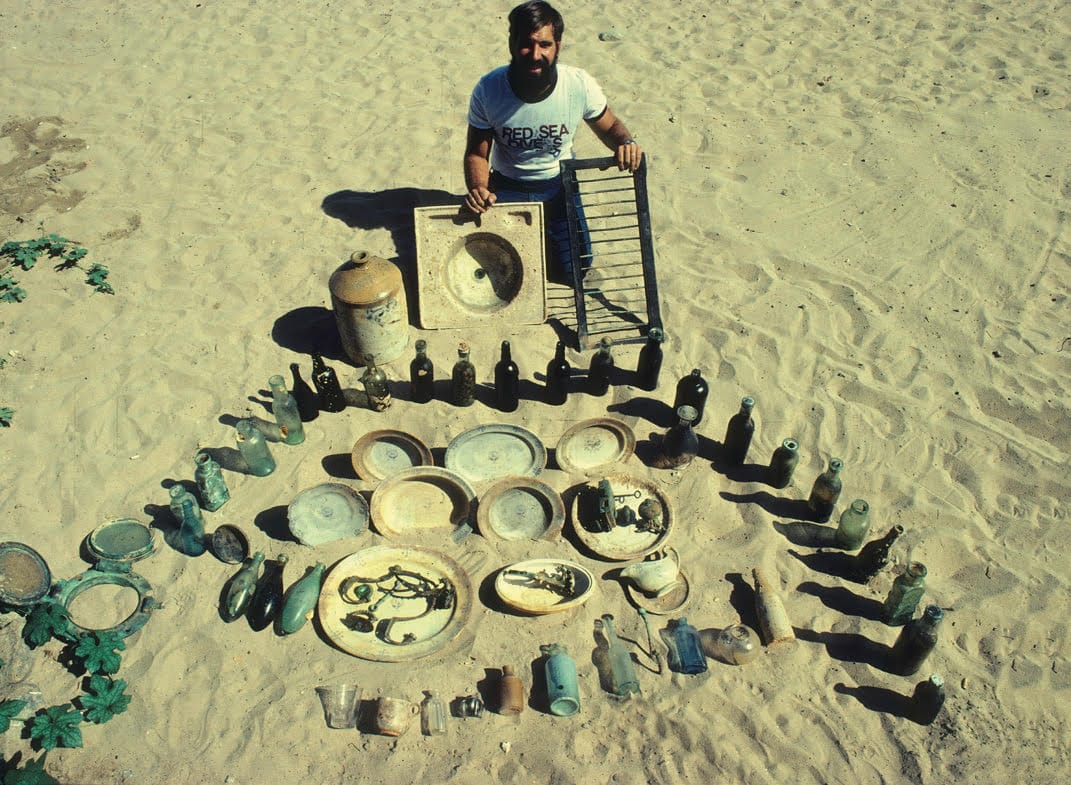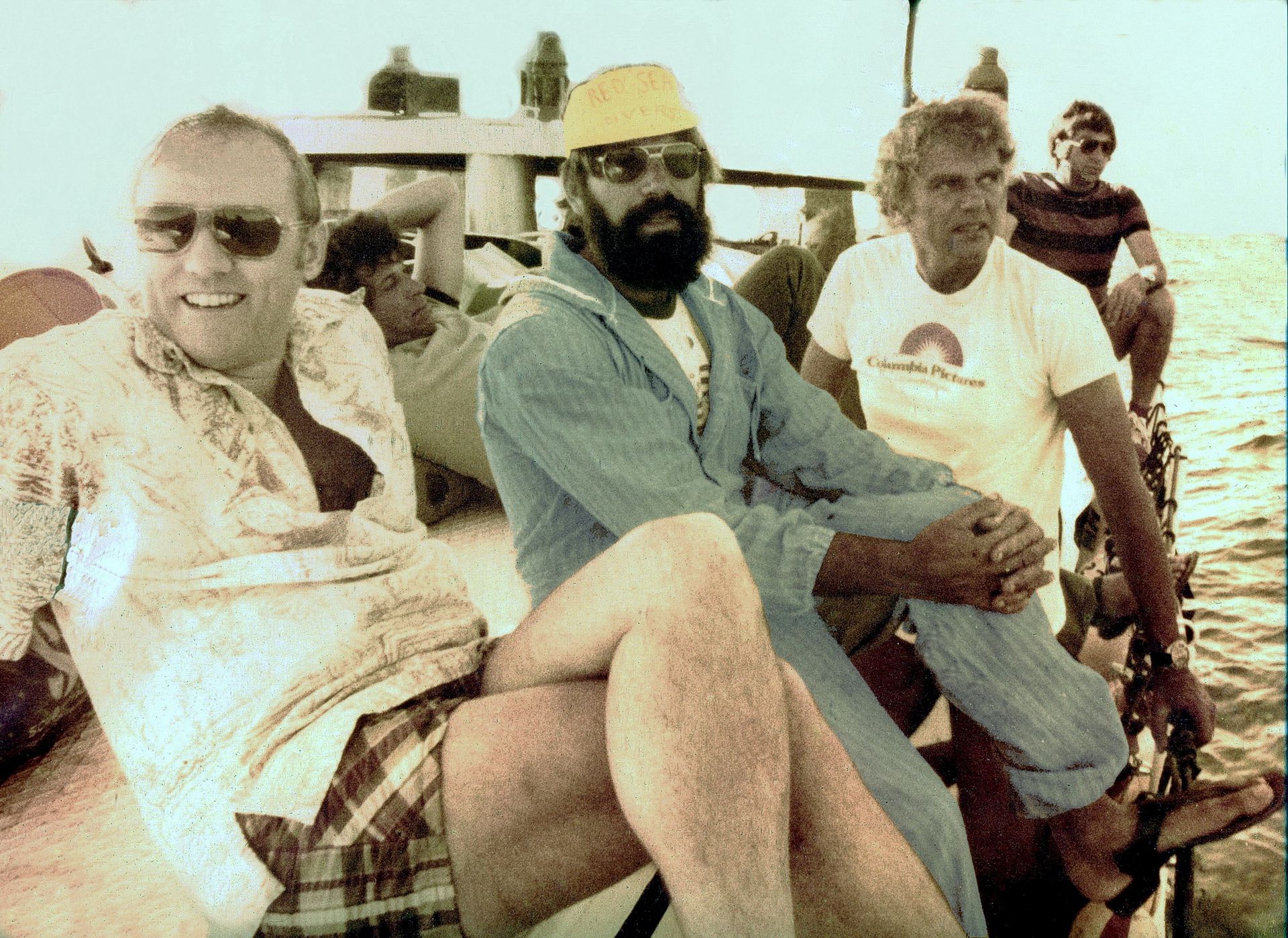- Inside Scuba
- Posts
- The Accidental Discovery of the SS Dunraven: A Red Sea Legend Born from Ingenuity and a "Three Cigarette" Map
The Accidental Discovery of the SS Dunraven: A Red Sea Legend Born from Ingenuity and a "Three Cigarette" Map
I am incredibly thankful to my friend, Howard Rosenstein, for generously taking over an hour of his time to speak with me and for subsequently sending a wealth of supporting material for this article. His firsthand account brings to life the fascinating story of the SS Dunraven, a popular dive site in the northern Egyptian Red Sea, and sheds light on the adventurous early days of diving in the region.
The northern Egyptian Red Sea is home to countless underwater wonders, and among its most popular dive sites is the enigmatic wreck of the SS Dunraven. This upside-down steamship (still equipped with masts for sails), resting near Sha'ab Mahmoud Reef, holds a captivating history, not least of which is its unconventional "discovery" by Howard Rosenstein, owner/operator of Red Sea Divers out of Sharm El Sheikh, in 1977. But the true story is a fascinating blend of early tourism struggles, clever marketing, and a fortuitous tip.
In the early days of his dive center, Howard and his team ran a very basic operation at the "end of the world in the Sinai." Without traditional advertising budgets, they desperately sought ways to generate interest in what they sincerely believed was a special diving destination. Howard, a pioneer in promoting Red Sea diving, had already embarked on a 1973 marketing trip to Europe and the US, giving slideshows to dive clubs and even connecting with Paul Tzimoulis, the powerful editor of Skin Diver Magazine. Despite these efforts, paid advertising remained out of reach. "We couldn't afford paid advertising," Howard recounts, "we had to get editorial stuff, maybe we could host a journalist for a diving holiday."
The Birth of a Myth: Lawrence, Gold, and "The Deep"
The turning point for the Dunraven's public emergence came from an unexpected source: a brainstorming session inspired by popular culture. Howard and his graphic artist and dear friend, Shlomo Cohen (creator of the revolutionary Red Sea Diver's Guide), were discussing the blockbuster movie "The Deep." This Peter Benchley film, starring Jacqueline Bisset, with its focus on wreck diving, had ignited a global fascination with underwater sunken treasures.
"Shlomo said, 'well you know, we need a wreck.' I said, 'yeah, sure, we need one, but we don't have one.' He says, 'well, let's make up a story,'" Howard vividly recalls. And so, over beers one night, a legendary marketing ploy was born: the fabricated tale of Lawrence of Arabia transporting gold on a ship in 1917, lost somewhere in the Red Sea while he was rallying Bedouin fighters against the Turks at their base in Aqaba (now Jordan).
This imaginative narrative wasn't just a campfire story. Howard's team began sending out "teasers" to interested dive travel agents, hinting at a found wreck with gold, while mischievously claiming they lacked "clearance" to take people diving on it. Articles about this "mysterious wreck" even appeared in major diving magazines, creating a buzz and drawing divers to Sharm El Sheikh, eager to be part of the eventual "discovery."

Shlomo Cohen’s sketch of the SS Dunraven
The Real Clue: Three Cigarettes to a Wreck
While the Lawrence of Arabia story was pure fiction, Howard genuinely sought a wreck to eventually reveal. His quest led him to an old Bedouin fisherman. When Howard "quizzed him about possible wrecks," the fisherman offered an almost mythical direction: he thought there might be "something out around Ras Mohammed point in the Gulf of Suez," and to find it, one should travel in the direction of the setting sun and smoke three cigarettes. "By the time you have finished your third cigarette, you should see a coral reef far off of the shore, at its southwest point you might find a sunken ship," the fisherman advised. This unique, low-tech navigation method led Howard directly to the site of the SS Dunraven, confirming its approximate discovery in 1977. Howard maintains, "that's my version of it. And that's more or less been the version that's been accepted internationally."

The Bedouin fisherman explaining to Howard how to find the wreck
The Dunraven's "discovery" wasn't without its contenders. Howard acknowledges several others who later claimed to have found it first, including a former student, Arieh Keller, and veteran diver "Big Alex," then working as a shark fisherman in the area. Howard's response to these claims is firm: "I never really said I was the first one, others made that claim, after the fact…what is undisputed is that I was the first one who brought attention to it. I was the first one to do the research on it and to advertise and actually open it up to the world."
Unveiling the Dunraven's Identity
Confirming the wreck's true identity took time. "We didn't know for a good year at least," Howard states. The breakthrough came when a dive group which included the American Ambassador to Israel, Samuel Lewis, chanced upon the ship's galley. There, they found porcelain plates bearing the ship's name. Further confirmation came from a more arduous task: Howard's team, including Shpir, a high-ranking officer in the Israeli SEALs and a salvage expert, used a pneumatic grinder to clear coral from the stern of the ship, revealing the name "Dunraven" etched into the hull itself.

Graphic artist and author Shlomo Cohen and Howard getting ready to dive the Dunraven
Artifacts found on board, such as torpedo bottles for Webb's double soda and other waters and plates designed by George Frederick Bowers (GFB), provided crucial historical clues. Their manufacturing dates pushed the wreck's timeline back to the 1870s, thereby debunking the more recent "Lawrence of Arabia" narrative, which would have fit the story better! Research confirmed the SS Dunraven, a British merchant ship built in 1873, sank on April 22, 1876, after striking a reef. Interestingly, no one perished in the sinking, and the captain, Edward Richards Care, was only 26 years old. Divers also found animal bones in a forward section of the ship, indicating it carried livestock for fresh meat.

Howard’s living room shows off his finds. This china cabinet is chock full of Dunraven finds.
 |  |
A Race Against Time and Changing Borders
The effort to document and explore the Dunraven became a "race against time" for multiple reasons. Beyond the typical urgency to explore a new wreck before others might salvage its secrets, a significant geopolitical factor loomed: the 1979 peace treaty between Israel and Egypt.
"The race of time was not because they wanted to get everything," Howard explains, "it's because that area was going back to Egypt." The Sinai was eventually divided on January 25th, 1980, with a line drawn that placed the Dunraven, along with famous dive sites like Ras Mohammed, squarely in Egyptian territory. Consequently, after 1980, the Dunraven became "out of limits" for Israeli dive operators. It wasn't until after the full withdrawal in 1982 that Howard's team could return, leading to a "hiatus of a few years" where access was restricted. Howard estimates that most of the easily accessible artifacts were salvaged within the first three years of discovery, between 1977 and 1980.

Finds from the Dunraven salvage
Bringing the Dunraven to the World
Howard's commitment to promoting the Dunraven went beyond initial discovery. He convinced Israeli film producer Dan Arazi of Kastel Films to produce a documentary, which garnered the interest of the BBC. Their prestigious documentary series, "The World About Us," featured the Dunraven, with famous underwater cameraman Chuck Nicklin contributing his expertise. Jack McKinney, the editor of Skin Diver Magazine, also produced a promotional film about diving in Sharm, which prominently featured the wreck. These efforts led to the wreck's "instant notoriety," with the film premiering at the DEMA show in 1979.

Left to right: US Ambassador Samuel Lewis, Director Eli Cohen, Howard Rosenstein and Cameraman Chuck Nicklin and producer Dan Razi during filming of “The World About Us”

Invitation to the premier of the film “God’s Other World - The Red Sea” produced by Jack McKenney.
Early diving on the Dunraven involved repetitive decompression dives. With no modern dive computers, divers relied on bladder-type SOS decompression meters (a forerunner to modern dive computers), conducting long stops and utilizing spare tanks on lines. Howard recounts a harrowing personal experience during a penetration dive where kicked-up silt caused him to lose sight of his backup tank. Running critically low on air at 100 feet (30 meters), he managed to locate the tank by following tiny bubbles from a leaking regulator, a moment he describes as one of the "scariest situations I had ever been in."
The Dunraven now rests inverted in two sections, at depths ranging from 49 to 96 feet (15 to 29.5 meters). Its discovery not only opened up a world-class dive site but also became part of a broader exploration of Red Sea wrecks. Howard's ventures post-1982 even led him to early explorations of other famous wrecks at the Abu Nuhas reef, like the Carnatic, highlighting the unique maritime history of the region following the opening of the Suez Canal and the transition from sail to steam ships.

A schematic of the ship’s plans
Today, the Dunraven remains a classic dive site, teeming with marine life and offering divers a tangible connection to maritime history, all thanks to the imaginative spirit, pioneering drive, and sheer determination of Howard Rosenstein.
This story and other exciting accounts about the early days of diving in the Red Sea can be found in Howard's captivating book, Treasures, Shipwrecks and the Dawn of Red Sea Diving. Available on the book’s website at www.olympusdive.com or the publisher’s site at DivedUp or Amazon. You can read my review of his book in our article Book Review: Treasures, Shipwrecks & the Dawn of Red Sea Diving By Howard Rosenstein. A live lecture by Howard about his book is also available on the author’s YouTube channel.
Reply